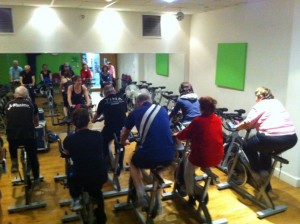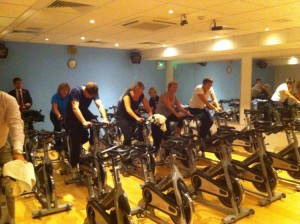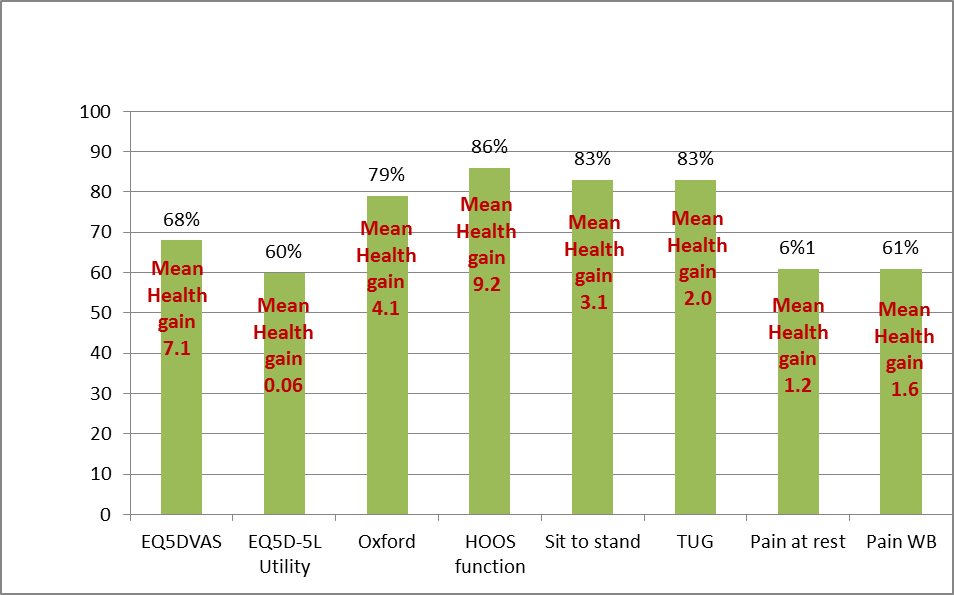Cycling against Hip PAIN (CHAIN)
The CHAIN programme was a service delivered at Littledown and Pelham Park Leisure Centres in Bournemouth to promote the self-management of hip osteoarthritis. The aim of the programme was to reduce pain and encourage mobility through a six week programme of education and static cycling sessions, to equip participants with the confidence to self-manage their condition. It ran from October 2013 to April 2015, and 119 participants took part in the programme.
Professor Middleton (Head) and Tom Wainwright (Deputy Head) of the Orthopaedic Research Centre conceived the programme as a way of implementing NICE guidelines (Overview | Guidance | NICE) (education and advice, exercise and weight loss where appropriate) for patients with hip osteoarthritis. It was developed in partnership with a collaboration of healthcare and activity providers: BH Live, The Royal Bournemouth and Christchurch Hospitals NHS Foundation Trust, Dorset Clinical Commissioning Group, Active Dorset, Bournemouth University, Bournemouth Borough Council and Christchurch Borough Council.
The programme consisted of a different 30 minute education session each week and a specially designed 30 minute graduated indoor stationary cycling exercise class. Difficulty and intensity of the exercise class were changed by altering the cadence (rate of pedalling) and the resistance of the static bicycle throughout the class. The education component, based on NICE guidelines, was facilitated by a qualified physiotherapist and was aimed at promoting the effective ongoing self-management of osteoarthritis of the hip. It included:
- Education and advice
- Exercise
- Lifestyle and general health
- Community links and signposting to information where necessary
- Monitoring of symptoms
- Information on diet and supplements
A home exercise programme including stretches and land-based exercise was developed with each participant and participants were given an exercise diary to complete outside of the programme to monitor their home exercise activity to act as an additional motivational tool and encourage adherence.
Participants were assessed for function, pain and quality of life before and after the programme, and for power output and pedalling technique using the WATT bike. They were sent details on their changes in the assessments after they had completed the programme.
Participant feedback included:
“I had been experiencing hip pain for four years and been advised I was looking at a total hip replacement. I wanted to avoid surgery if possible and had read about the CHAIN programme in the local paper. I have been very impressed and delighted with the results so far; most days experiencing significantly reduced hip pain. Now that the course sessions have completed I will continue spinning at my local leisure centre during the winter months and look at hiring a bike to cycle along Bournemouth promenade with my granddaughter when the weather improves. I have been very encouraged so far and look forward to seeing how I feel in three to six months time.”
“The programme made me realise that exercise was the best way to improve my pain and the use of my leg. It has made such a difference to me. I can now turn over in bed at night without having pain. I am determined to keep up with the exercise. Sometimes I don’t want to go out and walk the dogs, but once I am halfway through my walk I realise that I am walking more easily. I think it is important that you stick with the programme and the exercise. It is tough the first couple of sessions, but you need to see it through to get the benefits, and to acquire the knowledge and advice that will help. It is also really positive that it is done in a local leisure centre. I never realised how much support was on offer at these places, and the enthusiasm for exercise at the centre was really infectious.”
“I knew I was fitter and had lost weight, but I was very pleased with the much improved flexibility of hip and pelvis.”
“As a result of the course I did join the 37 mile Sky Ride through The New Forest two weeks ago and thoroughly enjoyed it”
“I have always exercised but recent hip pain, alongside other health concerns, meant I sometimes had difficulty even walking. I particularly found that the exercise element in the CHAIN programme was great. I always thought spinning on stationary bikes was for the super fit; I didn’t realise there were different levels and that I could work at my own pace. The sessions were really beneficial and I particularly enjoyed working within a group environment; I found this to be very motivating.”
Percentage of participants who had an improvement in outcome
EQ5D VAS/EQ5D-5L: a patient’s report of their general health and wellbeing. The visual analogue scale is from 0 – 100, a score of 100 being best health imaginable.
Oxford Hip Score: a patient-reported outcome which contains 12 questions on activities of daily living that assess function and residual pain. A score of 40+ suggests satisfactory function.
Hip Dysfunction and Osteoarthritis Outcome Score (HOOS) assesses physical function in patients with hip osteoarthritis. Scale is from 0-100, with 100 being the best possible score.
Sit-to-stand test is used to assess lower-extremity strength and balance. The score consists of time taken to stand up and sit down five times as quickly as possible.
The timed up and go test (TUG) assesses a person’s mobility. It comprises rising from a chair, walking 3m, turning, returning to a chair and sitting down again.
Pain at rest and pain on weight-bearing (WB) are measured on a visual analogue scale. The scale is 0-10, with 10 being the worst pain imaginable.
Further details can be found in the CHAIN report 2015.
UK Active Flame Award for Health Partnership of the Year Category
The CHAIN programme was a finalist in the ukactive and Matrix Flame Awards 2014, a highly coveted accolade in the health and fitness sector. The awards recognise suppliers, operators, educational institute, health practitioners and corporate organisations who have demonstrated exceptional standards across their area of work.
Publications
Funding Applications
NIHR Research for Patient Benefit
A funding application for £350,000 is being submitted in April 2015 for a randomised controlled trial, comparing an extended version of CHAIN (8-week programme) with usual physiotherapy care.
Innovation, Excellence and Strategic Development (IESD) funding
Active Dorset submitted an application to the above funders in March 2015. The funding is to support a three year project to deliver and evaluate the CHAIN programme in four new regions (West Dorset, Cornwall, South London and Shropshire). Applicants should hear by the end of the year whether they have received funding. Further information on IESD funding can be found at:
Programme set up in New Zealand based on CHAIN programme
Arthritis New Zealand. Joint Support. Newsletter Dec 2014 (p10).










Not only does the pain of arthritis limit work activity and availability but it also limits every aspect of a person’s life.Cycling is a good exercise.
Regular workouts helps in providing relaxation to the muscles and avoid stiffness. A good intiative.
Good article & excellent way to articulate. Keep it up.